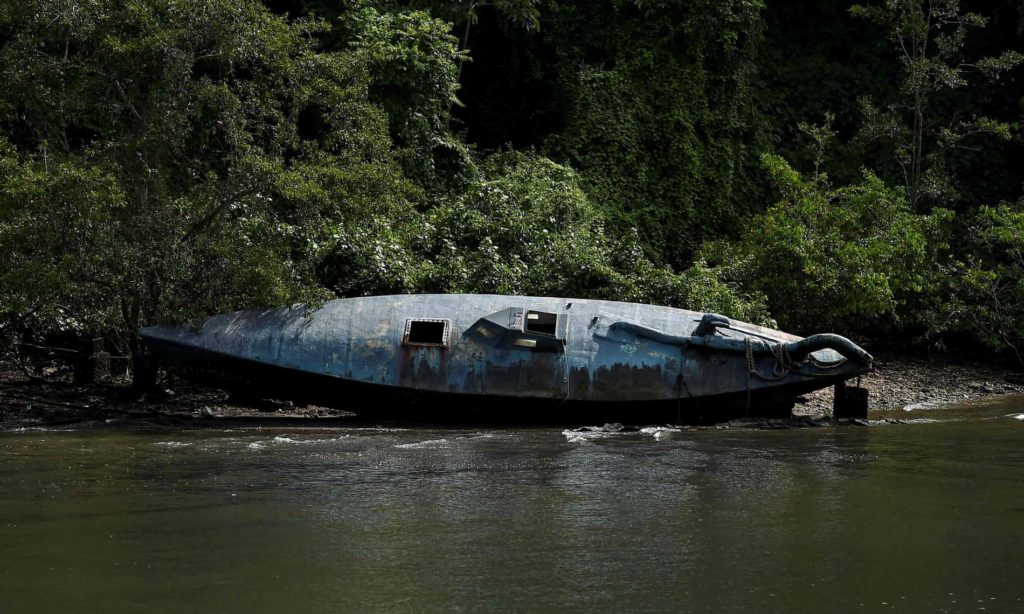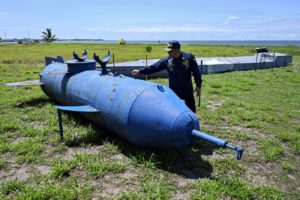Colombia’s narco-submarines now ‘commonplace’

For years, they were referred to, in hushed tones, simply as “Big Foot” – a mythical creature rumoured but never seen – but these days, the narco-submarines used by Colombia’s drug cartels have become almost commonplace, according to The Guardian.
With cocaine production at an almost record high in Colombia, authorities on the country’s Pacific coast say crude semi-submersible craft have become a favoured tool to smuggle drugs toward the US, and even to Europe.
Thirty-three submarines were intercepted in 2019, an average of almost three a month, most of them along the Pacific coast. That is a major concern for Hernando Enrique Mattos Dager, the rear admiral in charge of the Colombia’s Poseidon taskforce against drug trafficking.
“Large quantities of cocaine are transported by sea,” he says. “It is much easier to move a tonne of cocaine by sea than by plane because there are more checks on freight at airports.” Dager estimates that 80% percent of the country’s illicit drugs leave via the Pacific coast and 14% go via the Caribbean.
The rudimentary submarines, fashioned in secret workshops deep in the mangrove swamps of north-western Pacific coast, are notoriously difficult for navy patrols or radar to detect. They cruise “flush with the surface of the water, and the part that protrudes above the surface is very small,” Dager says.
For all their recent success, Dager and his taskforce know that they have probably only encountered the tip of the iceberg. As with all interceptions of illicit drugs, the feeling once the initial euphoria subsides is that many more get through than are ever detected. The authorities seized 433 tonnes of cocaine in 2019, more than half by the navy, but production was estimated to be more than 1,000 tonnes.
In November, a 22-metre semi-submersible vessel was intercepted on the other side of the Atlantic, off Spain’s Galician coast. It was carrying around three tonnes of cocaine, and two of its three crew members were reportedly from Ecuador.
Painted in blue, grey and pastel greens, the submarines’ fibreglass hulls appear to have more in common with Jules Verne’s Nautilus in his 19th-century novel Twenty Thousand Leagues Under the Sea than a sophisticated seagoing submersible. But these low-profile boats are designed to take to the sea with their decks awash, carrying their cargo just beneath the waves and out of sight.

The labyrinth of mangroves that make up 80% of Colombia’s Pacific coast provide ideal cover for the small boatyards where the submarines are made, according to Colonel Nelson Ahumada Ojeda, commander of the 4th Infantry Brigade and responsible for the Nariño coast. The army has little chance of tracing the vessels’ launching platforms in “a spider’s web of some 1,500 streams,” he says.
The cramped submarines are crewed by between two and four men, usually recruited from local fishing communities, often in Ecuador. If naval patrols discover them, the crew members “open valves to let in water and sink the vessel, sinking the evidence,” before jumping into the water, says Captain Victor Santos Pacheco, commander of the local coastguard, which often rescues crews from the sea.
The vessels can reach Central America in two or three days. Those that head further north to the Mexican or US coast are replenished at sea with water, food and fuel, indicating elaborate logistics. Crew members can earn up to $50,000 (£43,000) for a long crossing, but see it as a risk worth taking, according to officials. “A kilo of cocaine is worth $30,000 on the streets of New York,” says Dager.

“parasite” submarine
The cartels are constantly upping the ante in a cat-and-mouse game on the high seas. They are now using winged torpedo-like tubes known as “parasites” that are fixed to the hulls of large ships, Pacheco says. They also have a new tactic: a GPS-equipped “buoyed cargo” designed for clandestine recovery at sea.
Read the full article in The Guardian.










